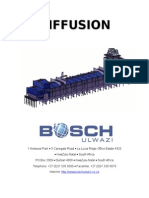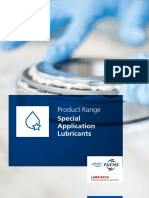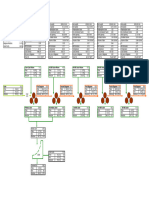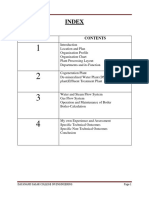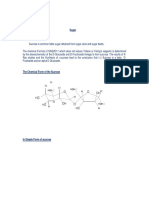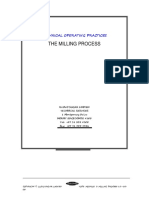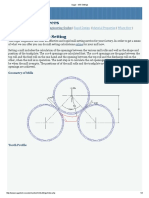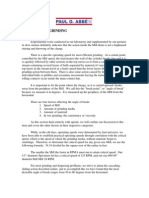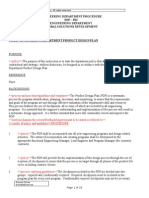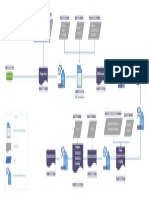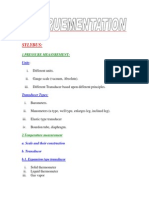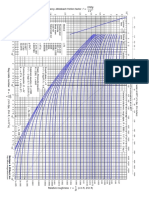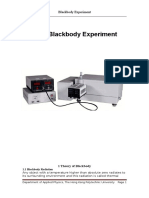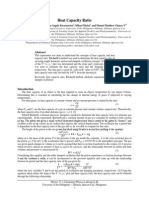Mill Bearings
Mill Bearings
Uploaded by
Omar Ahmed ElkhalilOriginal Description:
Copyright
Available Formats
Share this document
Did you find this document useful?
Is this content inappropriate?
Copyright:
Available Formats
Mill Bearings
Mill Bearings
Uploaded by
Omar Ahmed ElkhalilCopyright:
Available Formats
Sugar Mill Bearings
Page 1 of 3
The Sugar Engineers
Home | News | Prices | Engineering Guides | Rapid Design | Material Properties | Whats New |
Factories | Links | Contact |
Mill Bearings
Bearing Pressures
The maximum pressure that a bearing can withstand is mainly a
function of the bearing material. The bronzes that are common in
sugar mills have a recommended maximum bearing pressures of up
to 100 MPa for phosphor bronze and 50 MPa for tin-bronzes.
Standard sugar mill practise limits the bearing pressure to about 10
MPa.
Wed, 26 November 2014
SUGAR PRICE
25 Nov 2014
White
$/tonne
415.80
25 Nov 2014
Raw
/lb
16.00
Materials For Plain Bearings
The two essential elements in a plain bearing are the bearing or
bearing material itself, and the shaft or moving member. The bearing
or bearing material is located in a housing or structure, and may or
may not be integral with it. Separating these two elements is the
lubricant, introduced, generally in the case of sugar mills, by external
pressure feeding.
The material of the shaft or journal is established from considerations
of strength and rigidity, and will invariably be steel.
Because the conditions under which bearings must operate in service
may vary over a wide range, it is necessary that bearing materials be
used which have certain desirable properties. Amongst these we must
include such factors as
mechanical strength;
softness and low melting point;
low modulus of elasticity;
corrosion resistance;
high thermal conductivity; and of course,
economic considerations.
Since these factors cannot all be obtained to a desirable degree in a
single material, it is necessary in practice to make a compromise.
The most common bearing materials consist of
a. white metals,
You created
this PDF from an application that is not licensed to print to novaPDF printer (http://www.novapdf.com)
http://www.sugartech.co.za/extraction/millbearings/index.php
11/26/2014
Sugar Mill Bearings
Page 2 of 3
b. copperbase alloys, and
Sugar Books
c. aluminium-base alloys.
White Metal
White metals is a term used to include the tin and lead-base metals,
broadly referred to as Babbitts (after Isaac Babbitt, 1839), and since
such metals are highly competitive, they are recommended for most
applications where the loading is not severe. Babbitt bearings are
manufactured with the white metal lined onto steel, cast iron and
copper base alloys. Since white metal suffers a reduction in fatigue
strength with increase in temperature, and this reduction is a function
of thickness, it is usual to limit the thickness to between about
0.100-0.175 mm, and thicknesses of only 0.025-0.050 mm are used
with copperlead over the back-up material. White metal is not
commonly used as a sgar mill bearing material
Copper-base Alloys
Copper-base alloys including lead-bronze, gun-metal and phosphorbronze are widely used as bearing materials.
Lead-bronze is the cheapest, and is used for general service bearings.
It has a low tendency to seizure, in common with the white metal
bearings, and has greater fatigue strength to withstand higher
temperatures. Lead bronze bushes are frequently used in the form of
single, solid units, i.e. as bushes without the supporting shell
surrounding the bearing material, as is required of the Babbitt or
white metal bearing materials.
Fuels from Sugar
Crops
U.S. Department
of...
New $23.12
Best $19.45
The International
Sugar Trade
Tony Hannah,
Donal...
New $232.75
Best $221.17
The Chemistry and
Technology of
Furf...
K.J. Zeitsch
New $270.75
Best $195.03
Cane to Sugar
Julie Murray
New $23.08
Best $20.71
Handbook of Sugar
Refining
Chung Chi Chou
New $460.47
Best $69.00
Gun-metal provides a relatively cheap and easy to machine material,
having good bearing properties and capable of withstanding
somewhat higher loads than the lead-bronze alloys. This alloy also
has good resistance to corrosion in sea water.
Privacy Information
Phosphor-bronze is used for heavily loaded bearings, where high
frictional stresses are likely to occur. Because of the high hardness of
this material, it demands the use of a hardened steel journal.
Typical Sugar Mill Bearings
Rein in Cane Sugar Engineering states that typically sugar mill
bearings are tin bronzes with the following composition
Cu 84%
Sn 10%
Pb 3%
Zn 3%
Lubrication
You created
this PDF from an application that is not licensed to print to novaPDF printer (http://www.novapdf.com)
http://www.sugartech.co.za/extraction/millbearings/index.php
11/26/2014
Sugar Mill Bearings
Page 3 of 3
Sugar mill shafts do not turn sufficiently fast for a hydrodynamic film
of lubricant to be formed between the journal and the bearing.
Consequently hydrostatic lubrication is required. This is achieved by
supplying lubricant to the bearing under pressure. Under these
conditions, attention must be given to the adequate supply of
lubricant at all times, and in particular to the location of oil supply
holes and grooves.
Bitumin based lubricants are often used in sugar mill bearings.
Bearing Loads and Sizes
Specific roll loads are in the range of 2 to 3 MN per square metre of
projected roll area. This together with the allowable bearing pressure
mentioned above indicates that the total bearing area should be about
20% to 30% of the projected roll area
It is usual practise to allow the top roll of a sugar mill to float in the
vertical direction to:
keep a nearly constant pressure on the mat of bagasse in the
mill
allow some throughput variation without sacrificing extraction
protect the mill from damage from tramp iron
Typically hydraulic rams together with a gas accumulator provide the
downward force on the bearing caps to resist the upward force of the
bagasse on the mill roll. The gas accumulator acts as an air spring.
The hydraulic oil in the system is not compressible, but the gas in the
accumulator is and it is this gas that has the give that allows the roll
to float. The gas in the accumulator is precharged with a particular
gas pressure. The higher the precharge pressure the softer the spring
rate. A low precharge pressure will make the system very stiff and
may not allow sufficient float to let tramp iron through the mill, which
may cause damage. A high precharge pressure will make the system
very soft and the top roll bearing may continually rise up to its
maximum lift. This means the mill headstock may be subjected to
very high forces, not anticipated in design.
The correct precharge pressure which ensures that the top roll floats
about its design position is important to ensure good extraction and
to protect the mill from damage
You created
this PDF from an application that is not licensed to print to novaPDF printer (http://www.novapdf.com)
http://www.sugartech.co.za/extraction/millbearings/index.php
11/26/2014
You might also like
- Lab Report Flow Rate MeasurementDocument12 pagesLab Report Flow Rate Measurementnorsiah92% (12)
- Mill Training CourseDocument27 pagesMill Training CourseTung Bui Thanh100% (1)
- FLENDER Vertical Mill DrivesDocument16 pagesFLENDER Vertical Mill DrivesGaetan Berlin100% (2)
- Existing Capacity Calculation Sutiable For 13200 TCD (550TCH)Document13 pagesExisting Capacity Calculation Sutiable For 13200 TCD (550TCH)Omar Ahmed Elkhalil71% (7)
- Diffusion - HandoutDocument19 pagesDiffusion - HandoutOmar Ahmed ElkhalilNoch keine Bewertungen
- Chapter 11 CACCDHDocument60 pagesChapter 11 CACCDHmeda012Noch keine Bewertungen
- ItnDocument8 pagesItnPaolo FerrarottiNoch keine Bewertungen
- 11.design of Metal Plate Connected Wood Truss Joints For Moment PDFDocument8 pages11.design of Metal Plate Connected Wood Truss Joints For Moment PDFДаваажав Одгийв100% (1)
- Sugar CaneMill V5.1Document7 pagesSugar CaneMill V5.1uksraj100% (1)
- VIVI Trash Plate Heel Session - 2. - KP - Singh - 210318044122 - 2Document55 pagesVIVI Trash Plate Heel Session - 2. - KP - Singh - 210318044122 - 2Tung Bui Thanh100% (1)
- Optimisation of Fibriser Hub ProfileDocument4 pagesOptimisation of Fibriser Hub Profileamarnath jagirdarNoch keine Bewertungen
- Lubritech Product Range Special Application Lubricants en 12 2019Document76 pagesLubritech Product Range Special Application Lubricants en 12 2019Waheed AhmedNoch keine Bewertungen
- DIIPA Cane Unloading Handling Preparation&Milling 09042020Document36 pagesDIIPA Cane Unloading Handling Preparation&Milling 09042020Dheeraj ChauhanNoch keine Bewertungen
- 04 UlkaDocument53 pages04 UlkaKaruppannanMuthusamy100% (1)
- Sugar Cane Mills Control PDFDocument25 pagesSugar Cane Mills Control PDFJun Burias Padilla100% (1)
- Module 2 MillDocument120 pagesModule 2 MillAli Yimer Ali100% (2)
- Mill Misc ABSTRACTDocument21 pagesMill Misc ABSTRACTTung Bui Thanh100% (1)
- Mill HousingDocument10 pagesMill HousingOmar Ahmed Elkhalil100% (1)
- Mill BalanceDocument1 pageMill BalanceRizvanVavanNoch keine Bewertungen
- Ina Lubricants Product CatalogueDocument78 pagesIna Lubricants Product CatalogueDaniel DaiaNoch keine Bewertungen
- Sugar Factory Internship ReportDocument54 pagesSugar Factory Internship Report15, Sweekar Chougale100% (1)
- 1986 Anand A Self-Setting Mill - A Simple But Cost Effective InnovationDocument9 pages1986 Anand A Self-Setting Mill - A Simple But Cost Effective Innovationamarnath jagirdarNoch keine Bewertungen
- 79 Stai Annual Convention: Innovative and Sustainable Options For Improving Juice Extraction EfficiencyDocument38 pages79 Stai Annual Convention: Innovative and Sustainable Options For Improving Juice Extraction EfficiencyPrashantBudakeNoch keine Bewertungen
- 1999 Singh Pressure Chuteless Toothed Roller Feeding SystemDocument9 pages1999 Singh Pressure Chuteless Toothed Roller Feeding SystemTung Bui ThanhNoch keine Bewertungen
- Cane, Hareve, Weighing&handlling Plant (1)Document55 pagesCane, Hareve, Weighing&handlling Plant (1)Gebeyehu GetachewNoch keine Bewertungen
- Java Method Mill SettingsDocument1 pageJava Method Mill SettingsZahid MirzaNoch keine Bewertungen
- Mill ExtractionDocument10 pagesMill ExtractionBahtiar Yudhistira100% (2)
- 1994 Gibbon Cad Thrashplate DesignDocument3 pages1994 Gibbon Cad Thrashplate DesignnghiNoch keine Bewertungen
- Specification FOR Sprockets For Sugar Industry .: Indian StandardDocument2 pagesSpecification FOR Sprockets For Sugar Industry .: Indian StandardShrinivas BartakkeNoch keine Bewertungen
- Narendra Mohan Director: Email: Nsikanpur@nic - In, Director - Nsi@gov - inDocument33 pagesNarendra Mohan Director: Email: Nsikanpur@nic - In, Director - Nsi@gov - inBlessings HaraNoch keine Bewertungen
- 15 Chapter 5Document44 pages15 Chapter 5Taufik Binasr100% (1)
- US5126062Document6 pagesUS5126062hugo vignolo100% (1)
- Roller Mill MaintenanceDocument12 pagesRoller Mill MaintenanceJuan Carlos HuamánNoch keine Bewertungen
- BECHEM Special Lubricants For Open Gear Drives 2015 01Document11 pagesBECHEM Special Lubricants For Open Gear Drives 2015 01satfas100% (1)
- Sugar IndustriesDocument46 pagesSugar Industriesshine king100% (1)
- 3 MaterialDocument15 pages3 MaterialRajNoch keine Bewertungen
- Effect of Non-PolDocument6 pagesEffect of Non-PolKevynNoch keine Bewertungen
- En Cement Industry Open Cast MiningDocument8 pagesEn Cement Industry Open Cast MiningArnaldo Macchi MillanNoch keine Bewertungen
- A Comparison of Cane Diffusion & MillingDocument5 pagesA Comparison of Cane Diffusion & MillingRicardo Albino100% (1)
- Design Optimisation of FibriserDocument3 pagesDesign Optimisation of Fibriseramarnath jagirdar100% (1)
- Sugar Operational DetailsDocument8 pagesSugar Operational DetailsYadav ShwetaNoch keine Bewertungen
- Sugar Industry ChainsDocument57 pagesSugar Industry Chainszalabi100% (1)
- Energy Conservation in Sugar Industry1Document59 pagesEnergy Conservation in Sugar Industry1Sumit Bhati100% (1)
- SISSTA SEMINAR 2024 - Technical Papers OnlyDocument95 pagesSISSTA SEMINAR 2024 - Technical Papers OnlyArun Gupta100% (1)
- Design and Construction of Oil Expeller Press With Structural Analysis of Screw With AnsysDocument6 pagesDesign and Construction of Oil Expeller Press With Structural Analysis of Screw With AnsysShahzad AbbasNoch keine Bewertungen
- An Experience of (04) Massecuite Boiling System at Sanghar Sugar Mills LTDDocument11 pagesAn Experience of (04) Massecuite Boiling System at Sanghar Sugar Mills LTDHayat Ur Rahim Khan100% (1)
- Specifications of 1250Tcd Sulphitation Sugar Plant Expandable To 2000 TCDDocument73 pagesSpecifications of 1250Tcd Sulphitation Sugar Plant Expandable To 2000 TCDAHmad NaqashNoch keine Bewertungen
- Sugar Plant Design CalculationDocument78 pagesSugar Plant Design CalculationBarlo Yñigo AlcantaraNoch keine Bewertungen
- Cane Preparation and Juice ExtractionDocument54 pagesCane Preparation and Juice ExtractionPranetr R.100% (1)
- Unit2.SP - Mill.setting and ImbibitionDocument15 pagesUnit2.SP - Mill.setting and ImbibitionHari kant100% (2)
- Condenser ManualDocument4 pagesCondenser ManualTung Bui ThanhNoch keine Bewertungen
- Steam Consumption at Sulphitation / Raw Sugar Factories (Boiling House - Recent Trends)Document6 pagesSteam Consumption at Sulphitation / Raw Sugar Factories (Boiling House - Recent Trends)Yadav ShwetaNoch keine Bewertungen
- FinalDocument18 pagesFinalUmar AbbasNoch keine Bewertungen
- Issct 2013 Juice Extraction Systems PDFDocument19 pagesIssct 2013 Juice Extraction Systems PDFJeffersonPalacios100% (2)
- Diffusion Vs MillingDocument4 pagesDiffusion Vs MillingcbqucbquNoch keine Bewertungen
- CASE STUDY 2 - SteelDocument19 pagesCASE STUDY 2 - SteelAnkit UjjwalNoch keine Bewertungen
- Machinery Selection-Books14Document16 pagesMachinery Selection-Books14miningnova2Noch keine Bewertungen
- MillingDocument35 pagesMillingbonginkosi mathunjwaNoch keine Bewertungen
- Sugar Manufacturing ProcessDocument20 pagesSugar Manufacturing ProcessYadav ShwetaNoch keine Bewertungen
- Vacuum Filter Description in Sugar Industry - Optimization of Sugar LossDocument8 pagesVacuum Filter Description in Sugar Industry - Optimization of Sugar LossYounas Sardar100% (1)
- Juice Sulphitation Process - Methods of Sugar Cane Juice SulphitationDocument6 pagesJuice Sulphitation Process - Methods of Sugar Cane Juice SulphitationYounas Sardar0% (1)
- Sugar - Mill SettingsDocument3 pagesSugar - Mill Settingsgustool7Noch keine Bewertungen
- Molykote For Sugar Mill Machinery Call +91-98851-49412Document4 pagesMolykote For Sugar Mill Machinery Call +91-98851-49412Project Sales CorpNoch keine Bewertungen
- NTN Bearings MaterialsDocument2 pagesNTN Bearings MaterialsCristina Andreea CrissyNoch keine Bewertungen
- Manufacturing Process For TMTDocument6 pagesManufacturing Process For TMTKratagya SinghalNoch keine Bewertungen
- Principles of Ball Mill GrindingDocument12 pagesPrinciples of Ball Mill Grindingaghilif0% (1)
- Small-Scale Poultry Production - Chapter 01Document5 pagesSmall-Scale Poultry Production - Chapter 01Omar Ahmed ElkhalilNoch keine Bewertungen
- Anaerobic Treatment of Vinasse From Sugarcane EthanolDocument9 pagesAnaerobic Treatment of Vinasse From Sugarcane EthanolOmar Ahmed ElkhalilNoch keine Bewertungen
- Steam Calculation: AssumptionDocument4 pagesSteam Calculation: AssumptionOmar Ahmed ElkhalilNoch keine Bewertungen
- Asset ValuationDocument3 pagesAsset ValuationOmar Ahmed ElkhalilNoch keine Bewertungen
- M13 - Materials Handling - Rev02Document10 pagesM13 - Materials Handling - Rev02Omar Ahmed ElkhalilNoch keine Bewertungen
- Engineering Department ProcedureDocument29 pagesEngineering Department ProcedureOmar Ahmed Elkhalil100% (1)
- Vacuum System ParametersDocument7 pagesVacuum System ParametersOmar Ahmed ElkhalilNoch keine Bewertungen
- Project Standards and Specifications Steam Trap Systems Rev01Document6 pagesProject Standards and Specifications Steam Trap Systems Rev01Omar Ahmed ElkhalilNoch keine Bewertungen
- Co Gen ProcedureDocument1 pageCo Gen ProcedureOmar Ahmed ElkhalilNoch keine Bewertungen
- 1211101E - Pump Selection Guidelines PDFDocument24 pages1211101E - Pump Selection Guidelines PDFkad-7Noch keine Bewertungen
- Instruementation 1Document12 pagesInstruementation 1Omar Ahmed ElkhalilNoch keine Bewertungen
- Sugar - Fluid Flow VelocitiesDocument4 pagesSugar - Fluid Flow VelocitiesOmar Ahmed ElkhalilNoch keine Bewertungen
- Ins PDFDocument3 pagesIns PDFOmar Ahmed ElkhalilNoch keine Bewertungen
- Integrated Ferroelectrics: An International JournalDocument10 pagesIntegrated Ferroelectrics: An International JournalBhabani Sankar SwainNoch keine Bewertungen
- Abaqus User Guide - Damage Initiation For Fiber-Reinforced CompositesDocument4 pagesAbaqus User Guide - Damage Initiation For Fiber-Reinforced CompositespeymanNoch keine Bewertungen
- Physics Making-ElectroscopeDocument2 pagesPhysics Making-ElectroscopeToni PurapNoch keine Bewertungen
- TallerDocument2 pagesTallerDaanBayterNoch keine Bewertungen
- 1966-Manson-Coffin Fattigue. P.P. GILLISDocument4 pages1966-Manson-Coffin Fattigue. P.P. GILLISAna Isabel Aguilar ReyesNoch keine Bewertungen
- ASTM D412 - Tensile Test For Vulcanised Rubber Dumbbells: (Type Text)Document3 pagesASTM D412 - Tensile Test For Vulcanised Rubber Dumbbells: (Type Text)sufyanNoch keine Bewertungen
- Project Report SpecimenDocument5 pagesProject Report SpecimenArun PrasathNoch keine Bewertungen
- 3 - Absolute, Effective and Relative PermeabilitiesDocument34 pages3 - Absolute, Effective and Relative PermeabilitiesAhmad MammadovNoch keine Bewertungen
- Nedal Alloy DataDocument1 pageNedal Alloy DataMurali KrishnaNoch keine Bewertungen
- Structures of Solids & X - Ray DiffractionDocument14 pagesStructures of Solids & X - Ray DiffractionAnonymous t7MdBjnONoch keine Bewertungen
- Al Stge CHE 411 Separation Processes II First Semester 1429/1430 H-2008/2009G AbsorptionDocument8 pagesAl Stge CHE 411 Separation Processes II First Semester 1429/1430 H-2008/2009G AbsorptionrockeygreatNoch keine Bewertungen
- Asme Sfa Sa 213Document14 pagesAsme Sfa Sa 213Mayank SinglaNoch keine Bewertungen
- SaaDocument41 pagesSaaAbdur RahmanNoch keine Bewertungen
- Moody ChartDocument5 pagesMoody ChartMajid KhanNoch keine Bewertungen
- Be Lab WriteupDocument8 pagesBe Lab WriteupRachel BeningtonNoch keine Bewertungen
- Electrical Actuators Lab's ProjectDocument17 pagesElectrical Actuators Lab's ProjectdeemahhwNoch keine Bewertungen
- Melt PointDocument25 pagesMelt PointlabaileyNoch keine Bewertungen
- Problem 13.208: Given: Find: Solution: 1 FU RU FL RLDocument6 pagesProblem 13.208: Given: Find: Solution: 1 FU RU FL RLRaissa BenjaminNoch keine Bewertungen
- Blackbody ExperimentDocument15 pagesBlackbody ExperimentSage ChauNoch keine Bewertungen
- CHM2 Q3 0202 Phase DiagramsDocument27 pagesCHM2 Q3 0202 Phase DiagramsKyu AmeriNoch keine Bewertungen
- Technical Paper - Heat Capacity RatioDocument5 pagesTechnical Paper - Heat Capacity RatiodatUPstudentdoeNoch keine Bewertungen
- List of Icommet 2017 PapersDocument25 pagesList of Icommet 2017 PapersWahyu SipahutarNoch keine Bewertungen
- Chapter 8Document117 pagesChapter 8subham kumarNoch keine Bewertungen
- Investigation of The Sliding Contact Properties of WC-Co Hard Metals Using Nanoscratch TestingDocument8 pagesInvestigation of The Sliding Contact Properties of WC-Co Hard Metals Using Nanoscratch Testingkannanmech87Noch keine Bewertungen
- 4 - PRESSURE VESSEL (Inspection and Testing)Document69 pages4 - PRESSURE VESSEL (Inspection and Testing)Wahyu Lailil FaisNoch keine Bewertungen
- Magnetic Properties: Rianne Alipio Juvy Joyce Gonzales Trina LoriaDocument70 pagesMagnetic Properties: Rianne Alipio Juvy Joyce Gonzales Trina LoriaMhark Louie T. SardañaNoch keine Bewertungen




